A DC cell phone or mobile phone charger is a device which charges a cellphone from an available DC supply source. The device converts the unregulated DC source into a constant current and constant voltage output which becomes safe for any mobile phone charging.
In this article I have explained how to build DC to DC cell phone charger circuits using 6 unique concepts. The first concept concept uses the IC 7805, the second concept works with a single BJT, the third idea uses a IC M2575, in the fourth method we try LM338 IC, the 5th circuit shows how to charge multiple mobiles from a single source while the last or the 6th technique shows us how to use PWM for implementing an effective charging of a mobile phone.
Warning: Although the concepts are all tested and technically correct, the author does not take any responsibility of the results, please do it at your own risk.
Introduction
A simple DC cell phone charger circuit is one of those mates of cell phone that cannot be ignored because a cell phone would be dead without a charger.
Normally a DC cell phone charger circuit come as an integral part of a cell phone package and we use it in conjunction with our AC mains supply.
But what happens if your cell phone gasps for power in the middle of a journey, probably when you are driving or biking away on a middle of a highway?
How it Functions
A very simple yet reasonably effective DC to DC cell phone charger circuit is discussed in this article, which can be easily built at home even by a layman.
Though the proposed charger circuit won't charge your cell phone at the rate equal to a normal AC to DC charger, nevertheless it will complete the function without fail and won't betray you for sure.
The proposed DC cellphone charger circuit can be understood with the following points:
We all know the general specs of a cell phone battery, it's around 3.7 volts and 800 mAH.
It means the cell phone would require at around 4.5 volts for initiating the charging process.
However a Li-Ion battery which is employed inside cell phones are pretty sensitive to bad voltages and may just blow off causing serious life and property issues.
Keeping this in mind the cell phone internal circuitry is specifically dimensioned very strictly.
The parameters just won't permit any voltage which may be even slightly out of the range of the battery specifications.
The use of the versatile IC 7805 in the circuit answers the above issue just perfectly, such that the charging voltage at its output becomes ideally suitable for charging the cell phone battery.
A high wattage resistor connected at the output of the IC makes sure that the current to the cell phone stays well within the specified range, though this might have not been a problem anyway, the cell phone would just refuse to charge if the resistor was not included.
1) Circuit Diagram of the DC cellphone charger

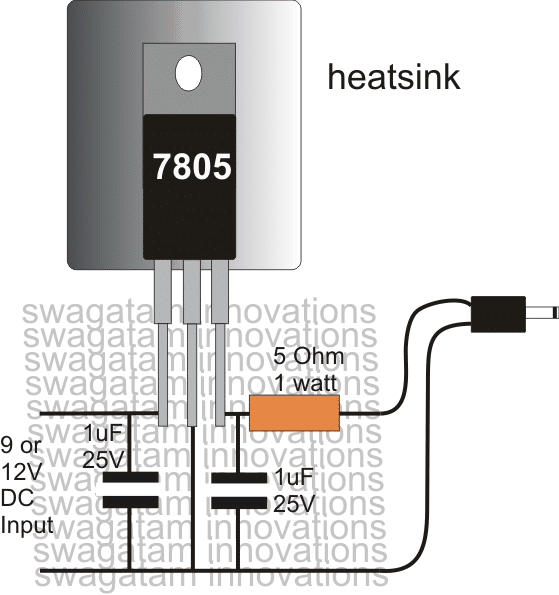
Pictorial Diagram
You can use this DC cellphone charger circuit for charging you cell phone during emergencies when there's no mains AC outlets, the circuit may be powered from any 12 volt lead acid battery or similar DC power source
Parts List
R1 = 5 Ohm, 2 Watt,
C1, C2 = 10uF/ 25V,
D1 = 1N4007,
IC1 = 7805, mounted on a heatsink,
Battery, any 12 volt automobile battery
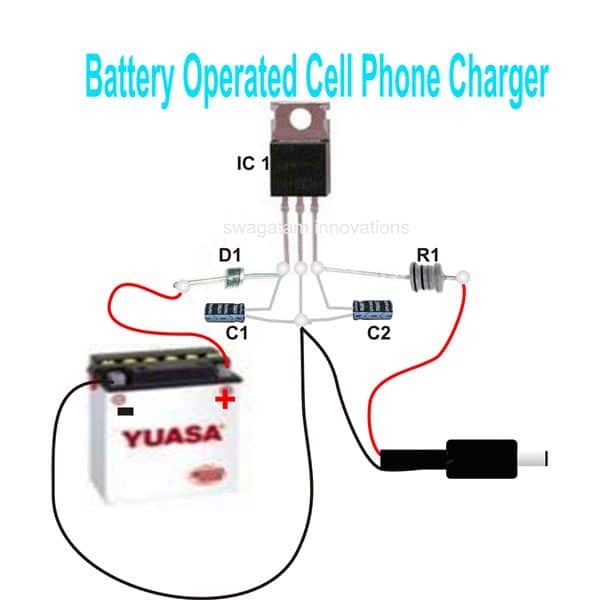
Using LM123/LM323
In the above concept a 7805 IC is used for charging, which can deliver a maximum of 1 amp. This current may not sufficient enough for charging smart phones, or cellphones with bigger mAH rating in the range of 4000 mAh. Since these high current batteries may require current up to 3 amps for charging at reasonably fast rate.
A 7805 might be completely useless for such applications.
However, the IC LM123 is one candidate which can fulfill the above requirement, by providing a precision 5 V output with a good 3 amp current. The input can be from any 12 V source such a car/motorcycle battery, or a solar panel. The simple 3 amp mobile phone charger diagram can be seen below:
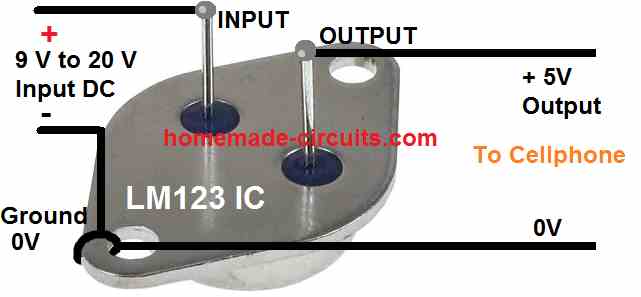
As can be seen above the 3 amp charger circuit requires no external components for implementing the procedures, and yet is extremely precise with its output voltage and current regulation, and is virtually nondestructive due to it many internal protection features.
2) DC Cell phone Charger using a Single Transistor
The next design explains a DC cell phone charger using a single BJT is probably the simplest in its forms and may be built very cheaply and used for charging any standard cell phone from a DC 12 volts external source.
Circuit Operation
The circuit diagram illustrates a rather straightforward design incorporating very few components for implementing the proposed cell phone charging actions.
Here the main active part is an ordinary power transistor which has been configured with another active part, the zenet diode for forming a nice little DC to DC cell phone charger circuit.
The resistor is the only passive component other than the above couple of active parts which has been associated in the circuit.
So just three component is to be used and a full fledged cell phone charger circuit is ready within minutes.
The resistor acts as the biasing component for the transistor and also acts as the "starter" for the transistor.
The zener has been included to inhibit the transistor from conducting more than the specified voltage determined by the zener voltage.
Though, a cell phone ideally requires just 4 volts for initiating the charging process, here the zener voltage and subsequently the output voltage has been fixed at 9V, because the current releasing ability of this circuit is not very efficient and presumably the power should be dropping to the required 4v level once the cell phone is connected at the output.
However the current may be decreased or increased by suitably increasing or decreasing the value of the resistor respectively.
If the cell phone "refuses" to get charged, the resistor value nay be increased a bit or a different higher value may be tried for making the cell phone respond positively.
Kindly note that the circuit was designed by me based on assumptions only and the circuit has not been tested or confirmed practically.
Circuit Diagram
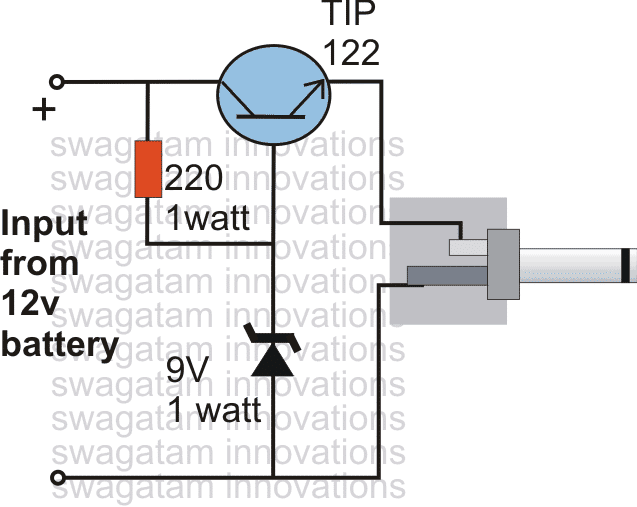
3) Using 1-A Simple Step-Down Switching Voltage Regulator
If you are not satisfied with a linear regulator charger, then you can opt for this 1 A simple step-down switching voltage regulator based DC cell phone charger circuit which works with a switched buck converter principle which enables circuit to charge a cell phone with great efficiency.
How it Works
In one of my previous posts I have explained about the versatile voltage regulator IC LM2575 from TEXAS INSTRUMENTS.
As can be seen, the diagram hardly utilizes any external components for making the circuit functional.
A couple of capacitors a schottky diode and an inductor of all that is needed to make this DC to DC cell phone charger circuit.
The output generates an accurate 5 volts which becomes very much suitable for charging a cell phone.
The input voltage has a wide range, right from 7V to 60V, any level ma be applied which results the required 5 volts at the output.
The inductor is introduced specifically for obtaining a pulsed output at around 52 kHz.
Half of the energy from the inductor is used back for charging the cell phone ensuring that the IC remains switched only for half the charging cycle period.
This keeps the IC cool and keeps it effectively in working even without using a heatsink.
This ensures power saving as well as efficient functioning of the entire unit for the intended application.
The input may be derived from any DC source like an automobile battery.
Courtesy and Original Circuit: ti.com/lit/ds/symlink/lm2575.pdf
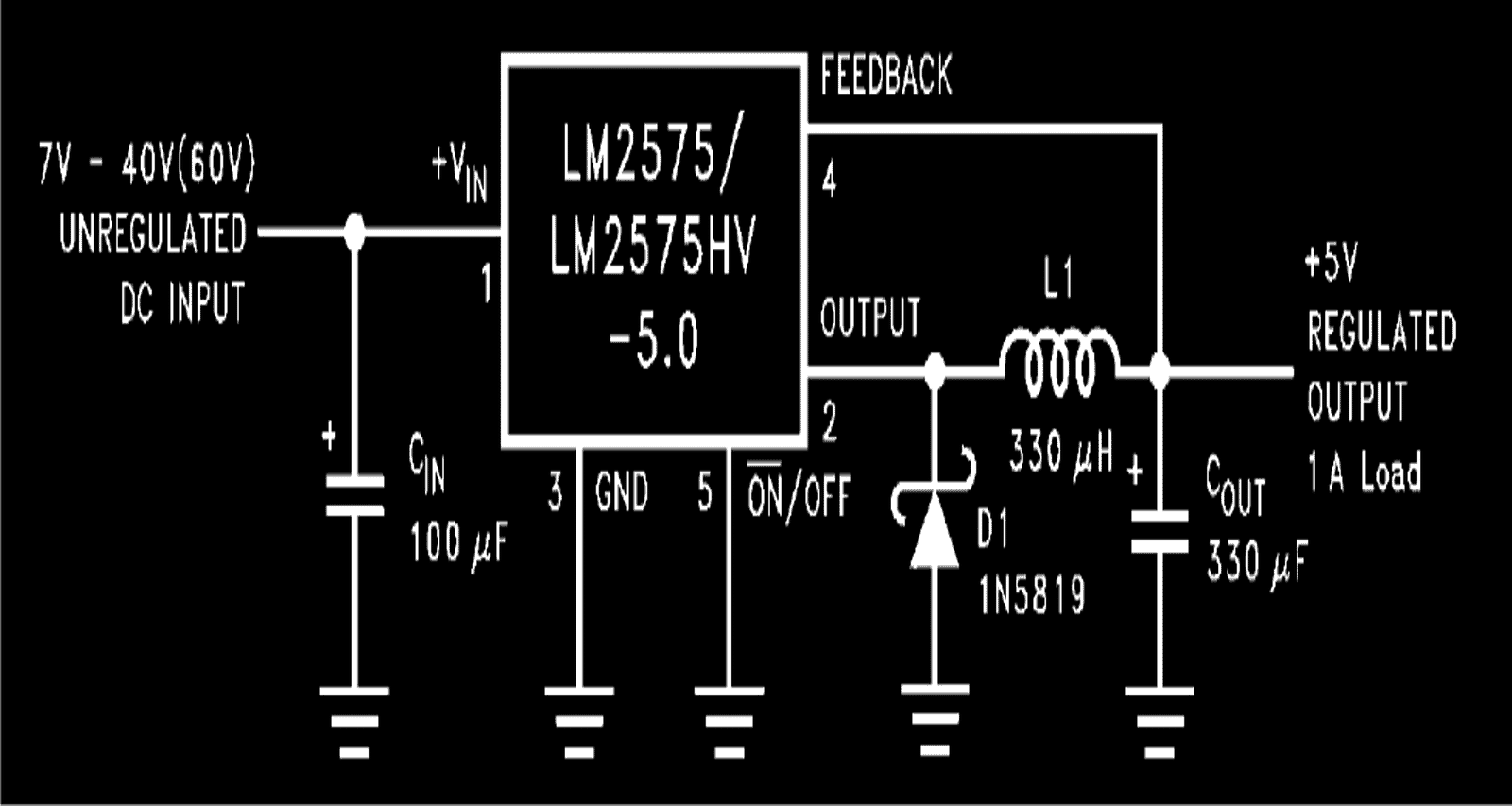
4) DC Double Cellphone Charger
A recent request from one of my followers Mr. Raja Gilse (via email), prompted me to design a DC double cellphone charger circuit that is able to facilitate charging of many cell phones simultaneously, I have explained how to make the circuit.
I have already explained regarding a couple of DC to DC cellphone charging circuits, however all these are designed for charging a single cell phone. For charging more than one cell phone from an external DC source like an automobile battery, requires an elaborate circuit.
Technical Specifications
Dear sir. Please tell me that what alterations should i do, to charge two mobiles at a time from your "12V BATTERY OPERATED CELL PHONE CHARGER CIRCUIT".(from bright hub) I am using the circuit from last 8 months, it's fine. Please post that article in your new blog also.
Dear sir, i tried so many time to post this comment in your blog in the "simple dc to dc cell phone charger circuit" but in vain. Please answer here~ Sir, i used another 10 ohm 2 watt resistor in parallel with the existing one, as i don’t have the higher watt resistor. It’s working fine. Thank you very much, i have one doubt, earlier, in bright hub in the same article you told to use 10 ohm resistor, but here it is 5 ohm which is suitable ?
I have another question out of this article; please guide me could I use three 1N4007 silicon diode instead of one 1N5408 silicon diode? My aim is to allow 3A current in only one direction. But i don’t have diode of 3A i.e. 1N5408. As 1N4007 is of 1 amps capacity could use three 1N4007 in parallel and like wise for 5A five 1N4007 in parallel, because i have number of 1N4007
rajagilse
Solving the Circuit Request
Hi Rajagilse,Use the following DC double cellphone charger circuit given below:
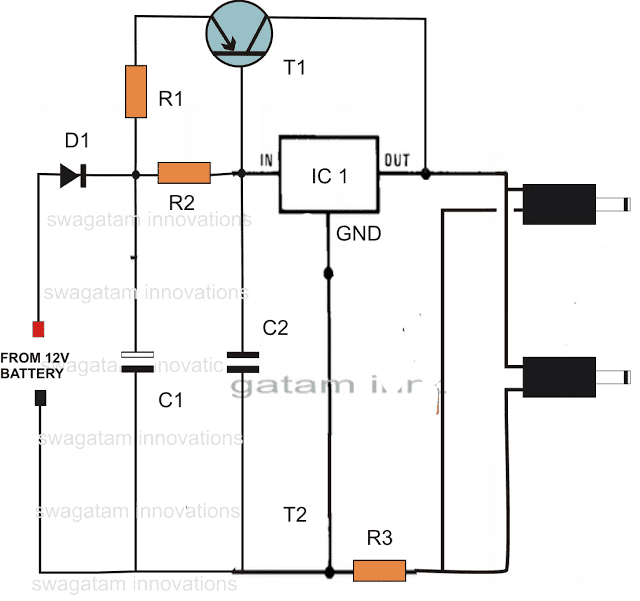
Hi Raja,
As you increase the limiting resistor value, the charging becomes slower, therefore a 5 Ohm resistor would charge the cell phone faster than a 10 Ohm, and so on. I'll check the problem with the commenting in my blog...however other comments are coming normally as usual! Let's see. Thanks and Regards.
Parts List
- R1 = 0.1 Ohms 2 watt,
- R2 = 2 Ohms 2 Watt
- R3 = 3 Ohms 1 watt
- C1 = 100uF/25V
- C2 = 0.1 discT1 = BD140 D1 = 1N5408
- IC1 = 7805
PCB Design
The circuit of the double DC cell phone charger was successfully tried and built by Mr. Ajay Dussa over a home designed PCB, the following images of the PCB layout and the prototype were sent by Mr. Ajay.
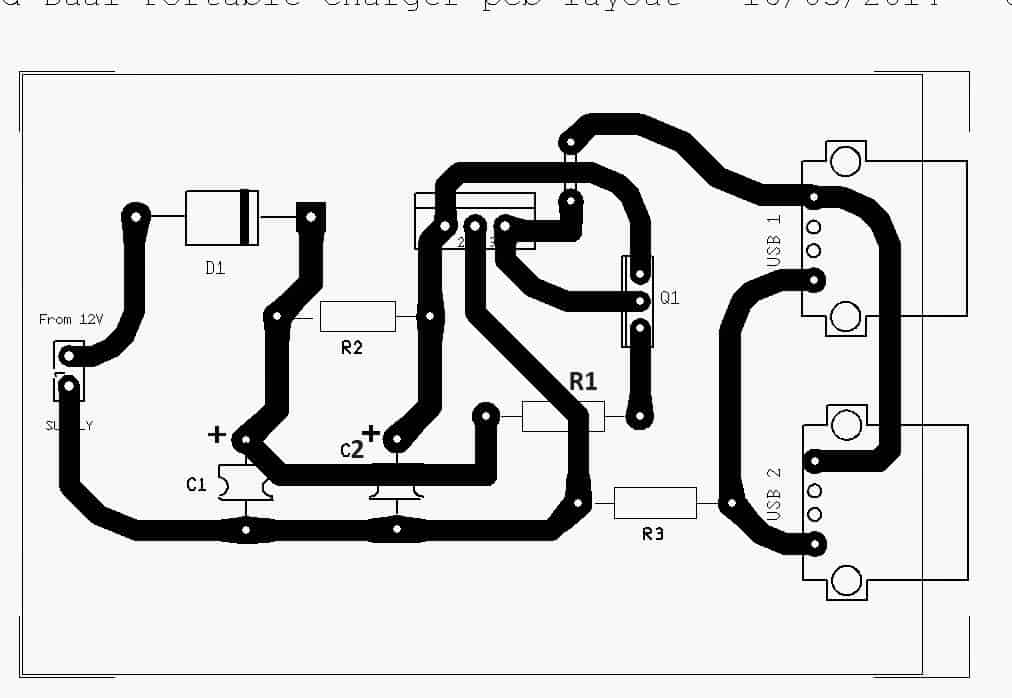
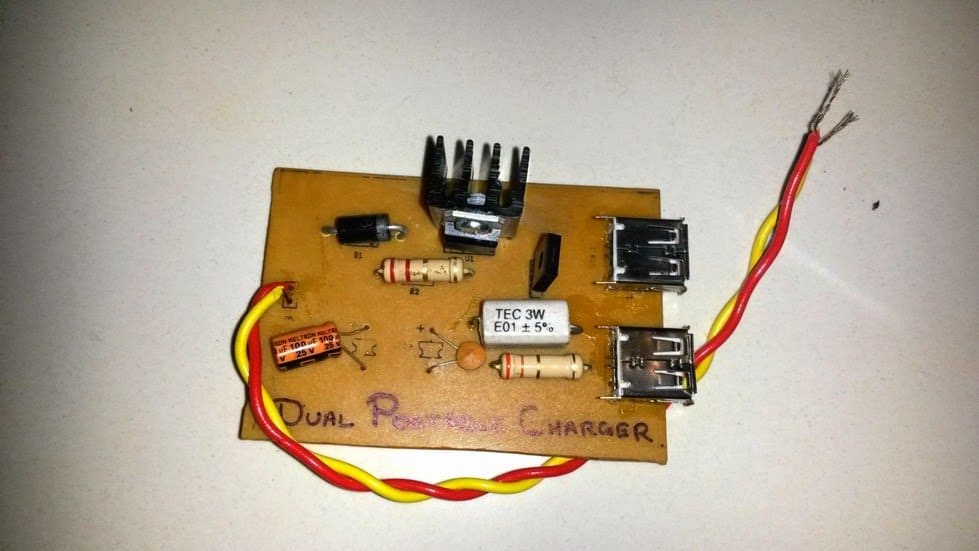
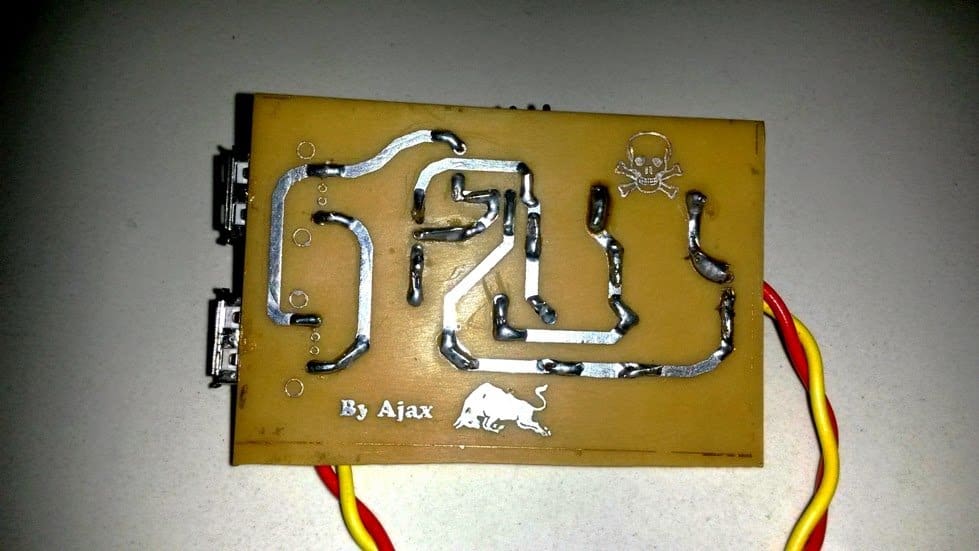
5) LM338 Based Cell Phone Charger Circuit
The following circuit can be used for charging as many as 5 cell phones at a time. The circuit employs the versatile IC LM338 for producing the required power. The input is selected to be a 6V but can be as high as 24V. A single cell phone can also be charged from this circuit.
The circuit was requested by Mr. Ram.
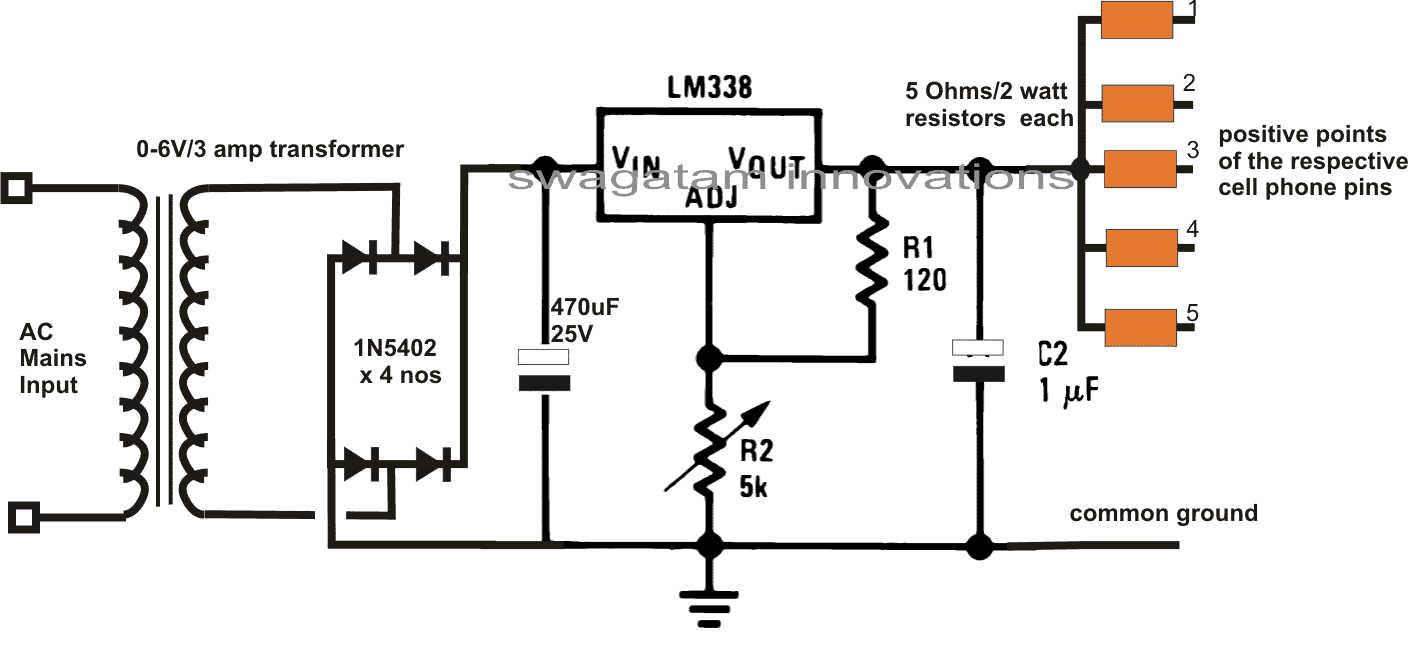
Multiple Cellphone Charger Circuit using IC 7805
Any desired number of cellphones can be charged by using IC 7805 in parallel as shown the following figure. Since the ICs are all mounted on the same heatsink the heat among them is uniformly shared ensuring a uniform charging across all the connected multiple cellphone devices.
Here 5 ICs are used for charging by medium sized cellphones, more number of ICs could added to accommodate more number of cellphones in the charging array.
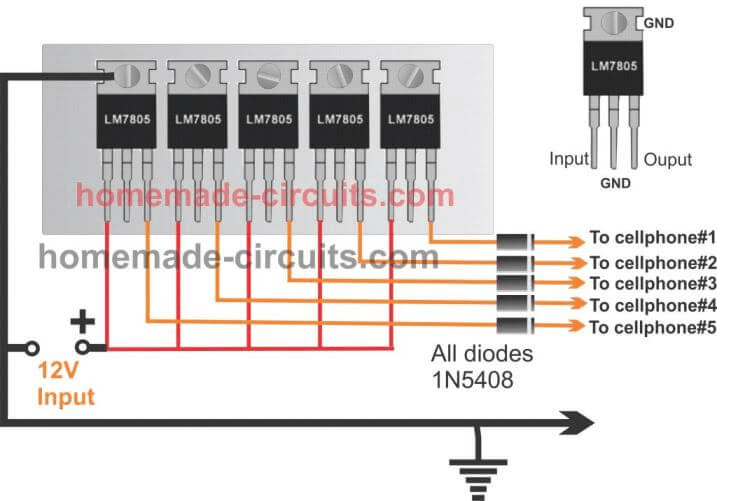
6) Using PWM For Charging Cellphone Battery
This circuit can be easily made at home by any school kid and used for displaying in his science fair exhibition. The circuit is a simple cell phone charger that may be operated in conjunction with any DC source, from a car or a motorcycle battery or from any ordinary 12 V AC DC adapter.
Nowadays we find most of the vehicles have their in built cell phone battery charger units which surely becomes very handy for travelers who mostly remain outdoors travelling in their vehicle.
The proposed cell phone charger circuit is as good as the conventional chargers which come fitted inside the cars and bikes.
Moreover the circuit can be simply integrated to ones own vehicle if the feature is not originally available in the vehicle.
Alternatively one may think of manufacturing the present unit and selling them in the market as an automobile cell phone charger and earn some hard bucks.
Circuit Operation
Cell phones as we all know are highly sophisticated gadgets by nature and when it comes to charging cell phones the parameters no doubt also needs to be of very high standards.
The AC/DC cell phone chargers which come with the cell phones are all SMPS based and are extremely good with their outputs and that’s why the cell phone gets so efficiently charged by them.
However if we try to make our own version, it may fail altogether and the cell phones may just not respond to the current and display a “not charging” on the screen.
Cell phone battery cannot just be charged by supplying DC 4 volts, unless the current is optimally dimensioned the charging won’t initiate.
PWM vs Linear
Using voltage regulator IC for making a DC to DC charger, which I have discussed in one of my earlier article is a good approach, but the IC tends to become too hot while charging the cell phone battery and therefore requires adequate heatsinking for remaining cool and operative.
This makes the unit a bit bulkier and moreover some significant amount of power is wasted in the form of heat, so the design cannot be considered very efficient.
The present PWM controlled DC to DC cell phone charger circuit is outstanding in its respect because, the involvement of PWM pulses helps to keep the output very suitable to the cell phone circuitry and also the concept involves no heating of the output device, making the entire circuit truly efficient.
Looking at the circuit we find that again the work horse IC 555 comes to our rescue and performs the important function of generating the required PWM pulses.
The input to the circuit is supplied through some standard DC source, ideally from an automobile battery.
The voltage powers the IC which instantly starts generating the PWM pulses and feeds it to the components connected at its output pin #3.
At the output the power transistor is used for switching the DC voltage at its collector directly to the cell phone.
However only the average DC voltage is finally fed to the cell phone due to the presence of the 10uF capacitor, which effectively filters the pulsating current and provides a stable, standard 4 volts to the cell phone.
After the circuit is built, the given pot will need to be optimized perfectly so that a well dimensioned voltage is produced at the output which may be ideally suited for charging the cell phone.
Circuit Diagram
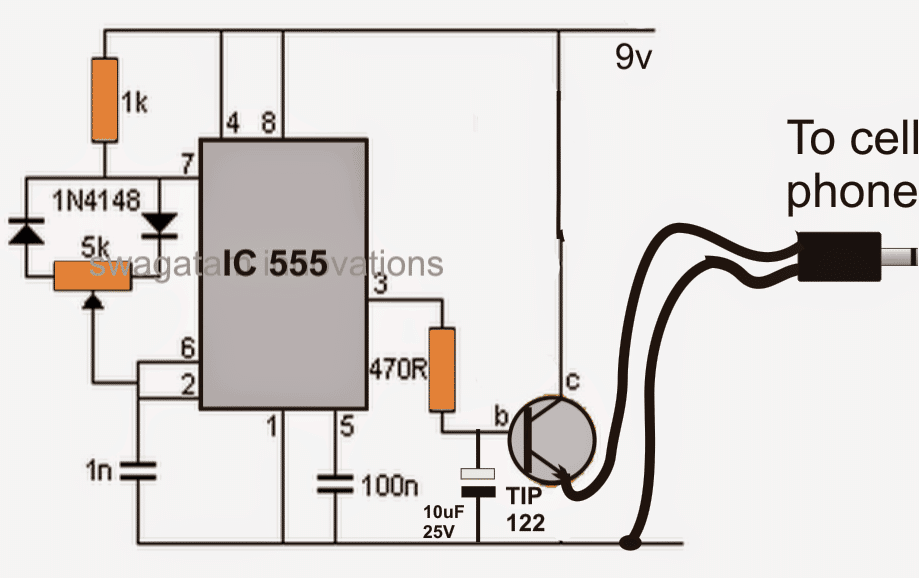

Hi I recently checked your circuit..
But I saw my mobile battery percentage can't be increased up..
Please give me a suggestion
Hi, please try reducing the resistor value to 1 ohm or 2 ohm and check the response
can i get 1 amp current from 7805 battery
yes you can, provided the IC is mounted on a large heatsink
What would happen if I use a 1K ohm resistor??will the charger work?
Will the charger work if value of resistor is decreased?
Thank you very much sir, i totally forgot, when ever there is a load on a SMPS/Transformers etc there is a voltage drop. Thanks much.
you are welcome!!
Hi, i am new to electronics, i was wondering, can i use a lm7806 not lm7805, because when i check the DC output with a multimeter of a cell phone's charger, the DC voltage is not a 5volts its 6volts, i don't want to cook my cell phone, so any help will be greatly appreciated. Thank you.
hi firstly one if the best learning electronics sites ever, thank you sir for sharing your knowledge with us appreciated. Sir i was wondering can i use lm7806 to make a power bank for charging a cell phone, because when i check a cell phone's charger with a multimeter the DC voltage is 6volts and not 5volts, i am new to electronics so i don't want to cook my cell phone, so any help will be greatly appreciated. Thank you.
Hi Lima, even with 10V your cell-phone will not fry because it has an internal voltage control protection.
however 5V is the correct recommended voltage for charging a cell phone. the 6V which you are seeing is due to the absence of load, as soon as you connect the cell phone, you will find it dropping significantly….so I would recommend you to use 5V and not 6V for the operations.
…and thank you for liking my site
what is the use of GND in 1805?
It is safe, because all cell phones have in-built automatic full charge cut-off circuitry
you can use the circuit with a car battery without issues
sir,
what was the out put Volts of that diagram sir?
Hai sir,
I made this circuit and my phone is charging, but its very slow and my phone battery is drawing around 250 mA.Is it working properly and what is the importance of 5ohm 1watt resistor. Also regulator ic is getting hot i am using a heat sink also i connected a cooler fan ( 12v) at the input pin of 7805. I am using an old 12v 7 AH battery. Plz guide me sir
Hi Sandeep,
you can try reducing the 5 ohm to some lower value for increasing the current and improve the efficiency….this resistor acts like a buffer and limits the current to an acceptable level, otherwise the phone circuit might refuse to accept the charge….
If you attach a large heatsink, then I don't think a fan cooling would be required.
Hi sir..hi do tho circuit..sOme mobiles can charge..my Lumia 720 couldn't get charged..how I modify the circuit?.. It's battery spec. is BP-4GW 20mah 3.7v 7.4WH Lithium polymer max 4.2
Hi Bibin, reduce the value of the 5 ohm resistor some lower value and check…
please specify the panel voltage??
testing
Dear sir
im using below circuit but im not using 5ohm R im using 4.7ohm resistance but my mobile was silly charging but not changing charging levels its constant please help me sir whats problem in my circuit
Govinda, you can try reducing the value to 1 ohms and see if that helps
This circuit work to possible high variation speed bike (45 kmph to 90 kmph)
What is there. D1 C1 C2 R1
Dear sir what is there d1 c1 c2. Etc tell me about this
you will have to experiment with the resistor to get the right current….or calculate it using Ohms law formula
Sir I want to make a mobile phone charger using transformer, bridge retifiers and capacitors as well as zener diode restriction is that there is no use of IC can u plz help me in finding the circuit and components I shall be very thanksful to you ..
Muhammad, you can do it by using 0-3V/500mA or a 0-4.5V/500mA transformer and rectifying its output with bridge/capacitor network. A zener diode will not be required for this, but make sure to add a current limiting resistor such as a 2ohm or 3 ohm 1 watt resistor.otherwise the cellphone might just refuse to accept the supply
Sir my battery is decreasing … Why ? … It supposed to be charged bur it isn't . 🙁
Hi
Can I use 4pcs 1.2v 2000mah rechargeable batteries in series to charge the cell phone battery directly, if yes then how the rechargeable batteries to be charged
Hi, please refer to the following article for more:
https://www.homemade-circuits.com/2012/11/homemade-cell-phone-emergency-charger.html
I mean ….can I use 9v,3w solar panel as input in this circuit?..I m using this..but output voltages are exact 4.50volts and ampereges are 1.70A…my cell phone charges few percent only..then stops charging but connection keeps there(charging)…
without load the output from a 7805 should be around 4.9 to 5.1V with a 9V input….if it's showing 4.5V then the IC could be duplicate or bad in quality.
and make sure the IC is not hot while charging the phone…use a large heatsink to avoid this
Sir…I will make the circuit mentioned by u in near future…One thing I want to ask…can i use 9V,3w solar panel as input source….?
you mean to say without 7805? It can be done by suitably increasing the 5 ohm resistor
Umair,you can use any value between 1 and 5 ohms which suits your mobile the best in terms of quick charging
what will happen if i use 7809 instead of 7805
It will still work
Ok..but sorry…this circuit just charge few percent(5-10%) very fast in first time connection..then stops and keep stops for many hours until I remove connection…no exceeding further…I check the voltages in USB port..these are good in between 475-520…but charging not increase.i have changed many input 12V batteries…what will be the problem…?
you can try the following circuit:
https://www.homemade-circuits.com/2012/01/how-to-build-simple-pwm-controlled-dc.html
but the pot will need to be adjusted very carefully for initiating the charging process…I have tested this circuit and this could charge a small cellphone within an hour
Sir I have made this circuit…Output voltages are 5.45V..charging speed is so high,10% in just about 10 minutes…but when disconnected..same case that discharging was so high…then steady at the same where from I start charging…
Umair, you must keep it connected until the cell phone indicates "battery full", if you remove it in the middle then it could drop quickly.
Sir I have made this circuit.my out put voltage is 5.20.but my cell phone charges only 2% or 3%.then it stays connected(charging) but percentage of charging not increases…like it shows very very slow charging.what is the problem and how I can solve this
Umair, try lower value resistor for the 5 ohm and check the response, initially you can try 3 ohms and see how it works.
Sir my mobile battery is a 5000mah. what adjustment should I do on your diagram to charge my battery more faster. Im using a 5volts with 1amp dc power.
emman, you can try connecting a transistor current booster with the IC 7805, and replace the 5ohm resistor with a 0.5 ohm resistor.
you can refer to the first diagram from the following article to learn how the transistor and the associated resistors need to be configured:
https://www.homemade-circuits.com/2012/05/dc-to-dc-double-cell-phone-charger.html
.
sir . i have 4 1.2 v ,1800amh battery, i want to make a power bank.I make it,but it charge only my nokia,samsung(old verson phone).it can not charge my redmi2 phone. redmi2 input voltage is 5v 1A. how can i make it.please help mw to solve it out.
Sobhan, try the bigger batteries instead of the AAA type…and check the response.
hi swagatam,
thanks for all ur valuable comments.
as u said cell phone will accept 5V only but how its possible may if we gave >5Volts also accepting because i have seen practically example motorola cell phone battery buldge or bad condition if you use long period using with compatible charger ERD charger. if i use original charger branded one then battery become good condition this thing i have observed long time by comparing both things so can u clarify me why my cell battery become buldge or bad what are reason ?
Hi Siddu,
all cell phones have internal overcharge protection and sophisticated voltage regulator circuitry, so what you are saying can NEVER happen unless you have used a duplicate battery inside the phone…..so the problem may be not in the charger but the battery used in the phone….or may be the cellphone itself could be a duplicate MOTOROLA, not an original motorola. 5V input is well handled by any cellphone, and if at all it anticipates a incompatibility the phone will simply stop charging.
about cell phone charger
Dear sir. Please tell me what alterations should i do, to charge two mobiles at a time from this circuit.Could i give the parallel connection with the existing mobile charging pin. As ic 7805 is capable of giving 1A out put. Please let me know
you can try the first circuit from here:
https://www.homemade-circuits.com/2012/05/dc-to-dc-double-cell-phone-charger.html
Can this circuit charge a phone with a 3000mAH battery?
My phone's charger outputs 5V , 2.1A . Though this will output max current till 1.5A and the charging will be a tad slower.
If you are having a 5V charger then I don't think the above circuit would be required…you can use the 5V charger directly to charge the cellphone.
Sir in the diagram you show C1 and C2=1uF But in parts list you write 10uF.which is right.You also write 5 ohm =1 watt but in parts list you write 2 watt pllzz guide me which is right..
Salman, C1, C2 values are not critical, you may use any capacitor in that place, the resistor could be 1 watt…. but 2 watt will provide even better cooling…so it's up to you to choose
can i use usb for charging
Hello sir,
My question is if we will used this ckt for long periods then it will occur damage in the mobile battery and mobile components pls give me the answer , thank you sir
Hello Jignesh,
No, there will not be any problem even if you connect the charger permanently with the cell phone because the cell phone internally has an over charge protector…which will instantly cut off the current as soon as the battery gets fully charged…however it's always a good practice to disconnect the charger through a visual monitoring….
Hello sir,
If we will used this ckt for long time then it will occur damage in the mobile battery and mobile components. Waiting for your answer sir ,thank you sir
Dear dharmendra, reduce the value of the resistor to 2 ohm and check
Dear sir
i wanna made a dc mob battery charger but , my mob display show battery power,decreaseing
plz send your views,
or contact no,
my self DHARMENDRA KUMAR ,I ALSO WANNA BE ELECTROLOGIST,
PLZ GIVE YOUR CONTACT NO , OR SEND AT erdharmendra30@gmail.com
sir mene ye circuit 12v 7amp dry battery me connect kiya but it does not work,,
just charging hoti rehti hy jese hi pin remove karo cell se to charging wohi ki wohi hoti hy:(
will u help me?????
this will not charge your mobile quickly, it might take 3 to 4 hours,
reduce R1 to 2 ohms and check whether it helps or not…
Dear sir can I use old cellphone batteries as a cellphone power bank if yes then how plz give a simple circuit
Rehan, no that's not recommended because old batteries may have different voltage and health conditions so they cannot be put in parallel for implementing the power bank.
hello sir
can u provide me a circuit to charge a laptop using 6v solar panel,
hello jyotiba,
you can try the following circuit:
https://www.homemade-circuits.com/2014/11/12v-car-laptop-charger-circuit-using.html
here you can use 6V as the input
sir ,Is it possible to build a circuit to charge a laptop using 6v solar panel,
if yes plz provide the link
Nitin, you can try the following design:
https://www.homemade-circuits.com/2014/11/12v-car-laptop-charger-circuit-using.html
you can use 6V panel as the input but make sure it's rated at 3 amps minimum
Hi sir this is Ravin Kumar.
what we have discussed about 7805, I was used 7805 as a Voltage regulator for mobile battery charger using 6V battery.
what is the problem I was facing is mobile in display showing charging symbol and connect sound ….!
But its charging % indication looks like decreasing condition…
I dont know what is the problem in that….!
Hi Ravin, when you connect the charging input to your mobile it should immediately acknowledge by showing the "charging" indication….the battery symbol should start showing a sequencing response….if this not happening then you can be sure that your mobile is not accepting the charge input.
do not use the mobile while it's being charged,, otherwise the charging level will start decreasing.
Sir in communication unit is their any chance to damage if short circuit happens..?
And is their any protection circuit…and it dint switched ON.
what is a communication unit, are you referring to a cellphone? with a 7805 IC there cannot be any danger…
Hi sir, Using 6V battery to charge mobile battery can I use as a 7805 as a 5v regulator…?
Hi Ravin, with a 6V input, a 7805 can be avoided….just use two 1N5408 diodes in series with the positive…that will do the job.
but if you prefer a 7805 you can try it as a 5V regulator.
I am getting 5 volts out put clearly (Input 6V battery) but mobile indication showing like decreasing slowly…is it possible to decreasing…?
after connecting the mobile should indicate "charging"…if this not happening that means your mobile is not accepting the input charge.
Hi.. sir I have Samsung Galaxy duos Gt I9082
Battery 3.8V Li-ion
2100mAh
can i charge it in my motorcycle battery using the above Circuit?
thanks in advanced.
Hi Jhud, you can do it, but use two 7805 ICs in parallel for getting a better current gain and quicker charging rate. Make sure that both the ICs are mounted on a common heatsink. also reduce R1 to 3 ohms/5 watts
…also add one 1N5408 diode in series with the output positive line, this will cut down the output to 4.3V approx…making it perfectly suitable for charging the 3.7V Li-ion cell.
However please remember that the circuit does not include an over charge protector so make sure to monitor it manually and remove it as soon as it gets fully charged.
Hi Jhud, you can use it with a 1 ohm 2 watt resistor instead of the shown 5 ohm….but still the the charging time could be much prolonged with this IC.
sir my model is shoe mobile charger can i use the circuit of battery opperated mobile charger in my model
Ajay, can you provide more details about the shoe charger, regarding its concept and voltage?
if the output from it is above 5V in that case you can employ the above shown circuits.
Hi sir,i am surya can i increase the watts of the R1 to10w it will work or damage the cellphone
Hi Suriya, yes you can do it, it will not affect the cellphone or the charging of the cellphone